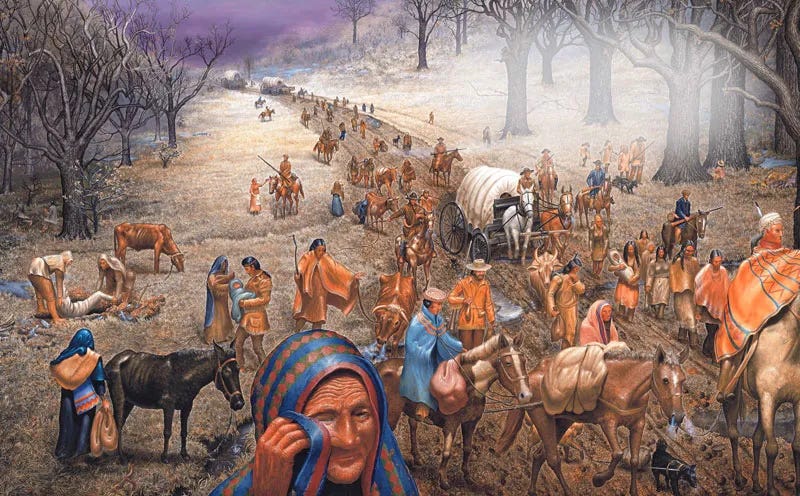From Ancestral Lands to Unmarked Graves: The Devastating Consequences of the Trail of Tears

The Trail of Tears was a dark chapter in the history of the United States. It began with the United States government's focus on westward expansion, and as a result, the lands inhabited by Native American tribes were seen as valuable resources that could be used for the benefit of the expanding nation. The Indian Removal Act of 1830 was passed to facilitate the removal of the Native American tribes from their ancestral lands in the southeastern United States and relocate them to Indian Territory in present-day Oklahoma.
The Native American tribes affected by the Indian Removal Act included the Cherokee, Creek, Chickasaw, Choctaw, and Seminole. These tribes were collectively referred to as the Five Civilized Tribes, as they had made significant efforts to assimilate into American society and adopt its culture.
The forced relocation of the Native American tribes began in 1830 and continued for several years. The relocation was carried out by the US government under the supervision of the military, and it involved the forced removal of thousands of Native Americans from their homes and lands.
While the Trail of Tears is often associated with the Cherokee tribe, the other tribes were also subjected to similar treatment. The Choctaw people were the first to be forcibly removed from their ancestral lands in 1831, followed by the Creek, Chickasaw, and Seminole tribes.
The relocation process was fraught with difficulties, and many Native Americans were subjected to inhumane treatment and abuse. The relocation was also marred by poor planning, and many Native Americans were forced to travel long distances on foot, with inadequate food, clothing, and shelter. This led to widespread illness and death among the Native American population.
Native American leaders and communities resisted the forced relocation and fought for their rights. One example of resistance was the Cherokee Nation's legal challenge in the Supreme Court case Worcester v. Georgia, which recognized the sovereignty of the Cherokee Nation and declared the Indian Removal Act unconstitutional. Despite this ruling, the forced relocation continued.
The Cherokee tribe was particularly affected by the forced relocation, and their journey is known as the Trail of Tears. The Trail of Tears began in 1838 and lasted for several months. During this time, the Cherokee people were forcibly removed from their ancestral lands in Georgia, Tennessee, Alabama, and North Carolina, and relocated to Indian Territory in present-day Oklahoma.
The Cherokee people were forced to travel over 800 miles on foot, and they were accompanied by the military, who were responsible for enforcing the relocation. The journey was fraught with difficulties, and many Cherokee people died from hunger, disease, and exposure to the elements. It is estimated that between 4,000 and 6,000 Cherokee people died during the Trail of Tears.
The Trail of Tears was a significant event in the history of the United States, and it had a profound impact on the Native American people. The forced relocation of the Native American tribes from their ancestral lands resulted in the loss of their cultural heritage, traditions, and way of life.
The legacy of the Trail of Tears is still felt by Native American communities today. Many Native American tribes continue to face significant challenges, including poverty, unemployment, and limited access to education and healthcare. In recent years, there have been efforts to address the legacy of the Trail of Tears and the mistreatment of Native American tribes. These efforts include initiatives to promote Native American rights and culture, as well as efforts to provide compensation and support to Native American communities affected by the forced relocation.
The Trail of Tears remains a tragic and dark chapter in the history of the United States, and its impact is still felt by Native American communities today. The forced relocation of Native American tribes from their ancestral lands represents a significant loss of cultural heritage and traditions. Although efforts have been made in recent years to address the legacy of the Trail of Tears and support affected Native American communities, more needs to be done to promote Native American rights, culture, and wellbeing, and to recognize the injustices that have been inflicted upon them. It is essential to remember this event and its consequences to work towards a better future for all.

